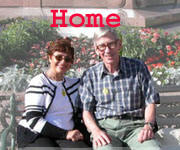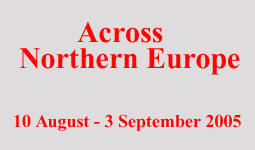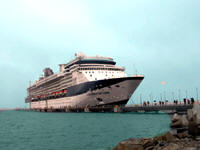Part II - Page 8 9 10 11 12 Go to: Part I Part III Part IV
KLAIPEDA
Wednesday, 23 August. The ship arrived in Klaipeda, Lithuania, at 8:00. Though it is very small now, Lithuania was once one of the largest states of Europe. Loosely joined with Poland in 1386, it became one of the most powerful, too, winning a major victory over Prussia at Tannenberg in 1410. In 1569 Poland and Lithuania formally merged. Unfortunate for both of them, Poland was partitioned out of existence (late 18th century), with Lithuania and much of Poland being absorbed into Russia. (The rest of Poland went to Austria and Prussia.) Like Estonia and Latvia, Lithuania emerged as an independent country between the World Wars, only to be merged into the Soviet Union in 1940. Following Nazi occupation from 1941 to 1944, it reverted to Soviet control. After the breakup of the Soviet Union, it regained its independence in 1991.
The excursion we’d signed up for, Klaipeda Old Town & Palanga Amber Museum, left at 9:30. The bus took us through the city, through gently rolling countryside, to the outskirts of Palanga, one of the two popular beach resorts outside Klaipeda. We were dropped off at the entrance to the 19th century Botanical Park. Our local guide led us on a leisurely walk across the park, and it couldn’t have been a more beautiful day for it. We passed the Count Tiskevicius Palace (1897) that houses the amber museum and came to a rock shrine. In front of it was a group of young musicians wearing folk costumes. They played for us while a young woman offered us the traditional bread of welcome. Eventually, some of the group formed a ring and began a folk dance, inviting us to join them. And of course, Jane, bad knees and all, was the first to join in.
We continued on through the Botanical Park to the beach. It was very nice, and sparsely used for such a beautiful day. I couldn’t resist the opportunity to go down and dip my hands in the Baltic, and even search for some stray amber. Then our guide led us back into the park to the Amber Museum and turned us loose. The collection was fascinating, including the world's largest known piece of amber (8 lbs.), dozens of pieces with various creatures embedded (including a snake!), all sorts of items either carved or assembled from pieces of amber (including a tractor), and a large assortment of beautiful jewelry. Finally we came to the gift shop, its walls lined with glass display cases filled with amber jewelry. Jane admired a particularly attractive set (necklace, bracelet & earrings), and we decided to buy it.
By now, though, most of our group had left the gift shop. The guide hadn’t specified when or where we were to meet, so I told Jane to go out and find the guide while I purchased the jewelry. When she got outside, she could just make out our group in the distance, heading in the direction where we’d first entered the park, and she chased after them. When I came out a few minutes later, there was no sign of the guide or the group. I wasn’t even sure we were supposed to meet the bus where it had dropped us, since the guide never said. Anyway, I decided to go in that direction, hoping to catch the group along the way. Then I realized that two confused-looking couples outside the palace were also from our tour group. But I thought if I waited for them I’d never catch the group, so I told them what I was doing and took off.
We’d come to the palace by a winding and indirect route, but fortunately I remembered each turn as I came to it. I finally caught the group at a sculpture not far from where we’d entered the park. The guide only then realized that she’d lost five of us. Then I retraced my steps until I came to the two couples and led them to the group. We all waited around the sculpture for another ten minutes. That made me even more upset with the guide because it demonstrated that there really was no reason for her not waiting for all of us before leaving the palace.
The bus left the park at noon and drove back to Theater Square in Klaipeda. This square, named after the neoclassical theater there (1819, rebuilt 1990), is the heart of the old town. Adolf Hitler spoke from the theater’s balcony in 1939 when Klaipeda was annexed to Germany. In front of the theater is the Anike fountain (1912, replaced in 1989 after disappearing during World War II). Anike was a young girl immortalized in a folk song by a German poet. Forming a semicircle opposite the theater were about 30 tables set up by the locals to sell things (mostly amber) to the tourists. This year (2005) is the first that major cruise ships visited Klaipeda. Consequently, the tourist industry is less developed than other ports we visited, not as much tourist “junk” is offered for sale, and prices for the local goods that are sold are more reasonable. We’d been told from the beginning of the cruise to put off buying amber until Klaipeda because that’s where the best bargains are. We found this to be true. We didn’t have time to shop just then, though, because our guide took us on a walking tour of old Klaipeda. We went through the Farmers’ Market, offering mostly local fruits, vegetables and flowers. After a few blocks, we stopped at Memelis, a German-style bar-restaurant in a reconstructed 19th century warehouse, where we all had a tall glass of beer. By then it was 1:00. The guide gave us an hour on our own before we were to meet again at Theater Square.
Jane and I walked to the sailing ship, Meridian, moored in the Dane River. We had seen it from the bus earlier. There was a good-sized market on the adjacent square. It sold mostly tourist goods, but there wasn’t a lot of amber.
We walked back to Theater Square, apparently the main site for amber vendors. We looked over the goods at every table, some more than once, before buying several necklaces and bracelets, mostly as gifts, and another ring for Jane. In the meantime, two o'clock had come and gone, and we told the guide we would walk back to the ship, just a couple blocks away. We started back at 2:20 and it took about 15 minutes to get to the ship. It was actually quite warm in the sun. We ate a light lunch by the spa, then rested until dinner. The ship sailed at 7:00 as we ate. We went to the 8:45 show, set our clocks back an hour, and retired.
Part II - Page 8 9 10 11 12 Go to: Part I Part III Part IV |


















